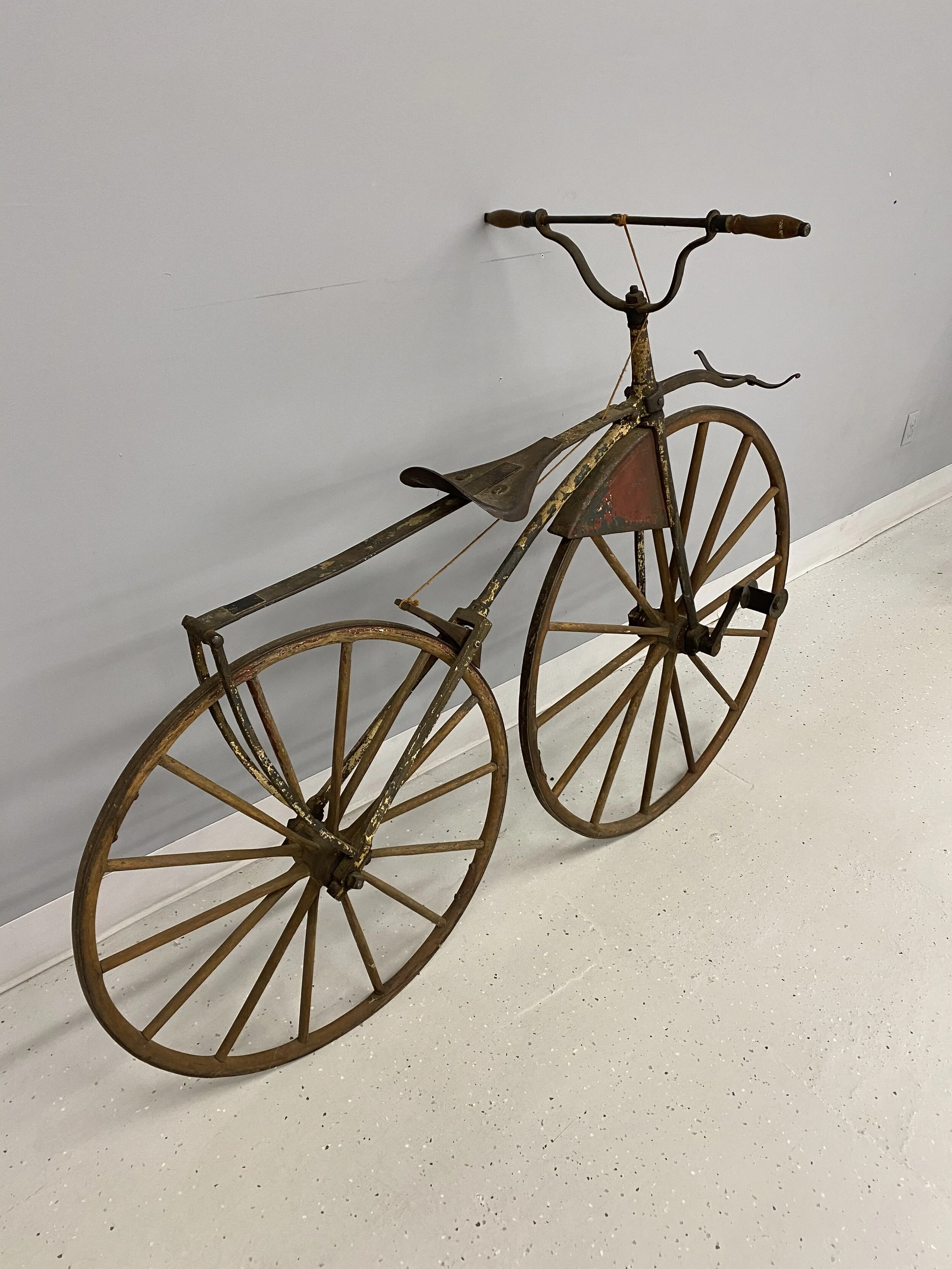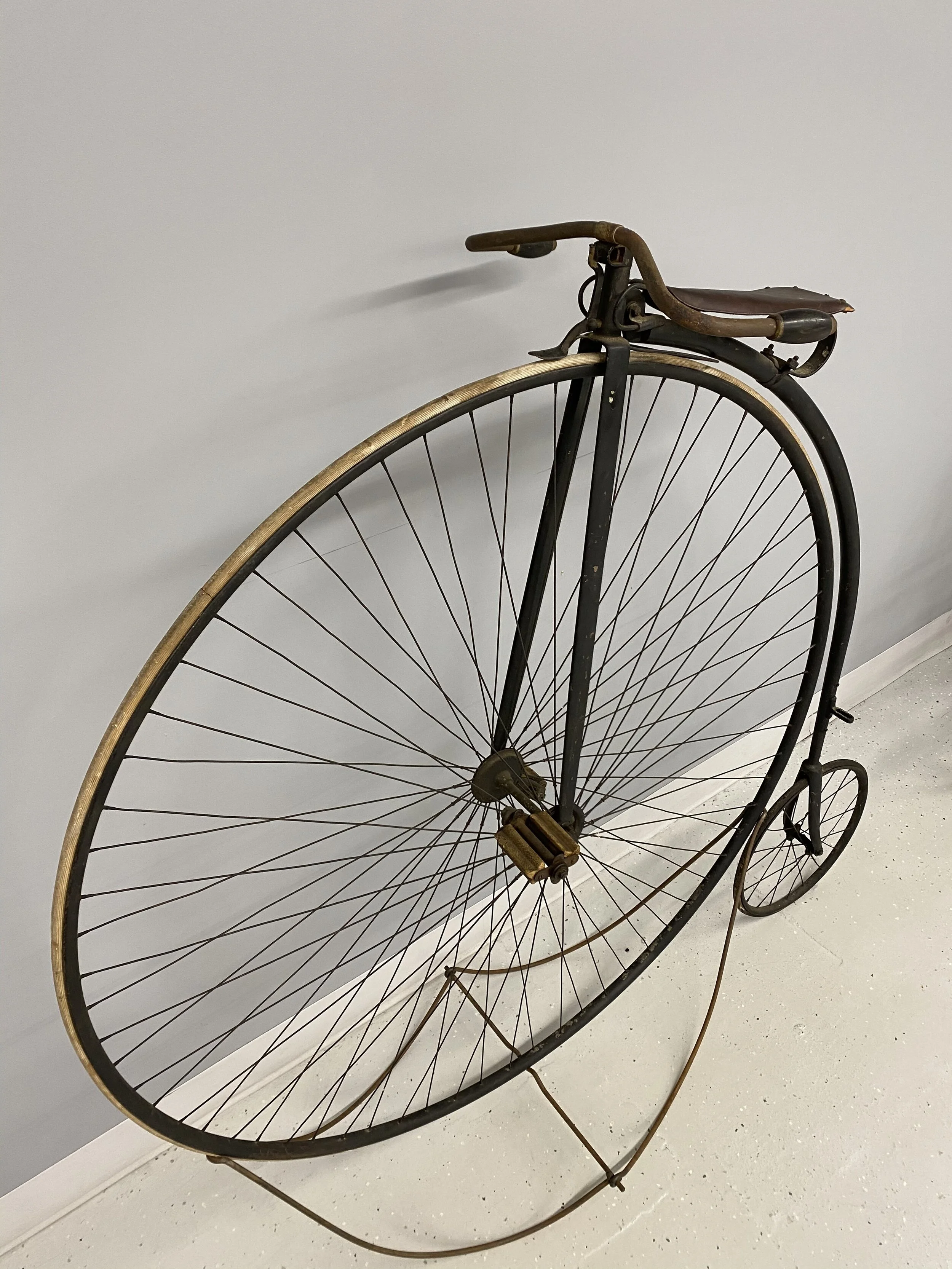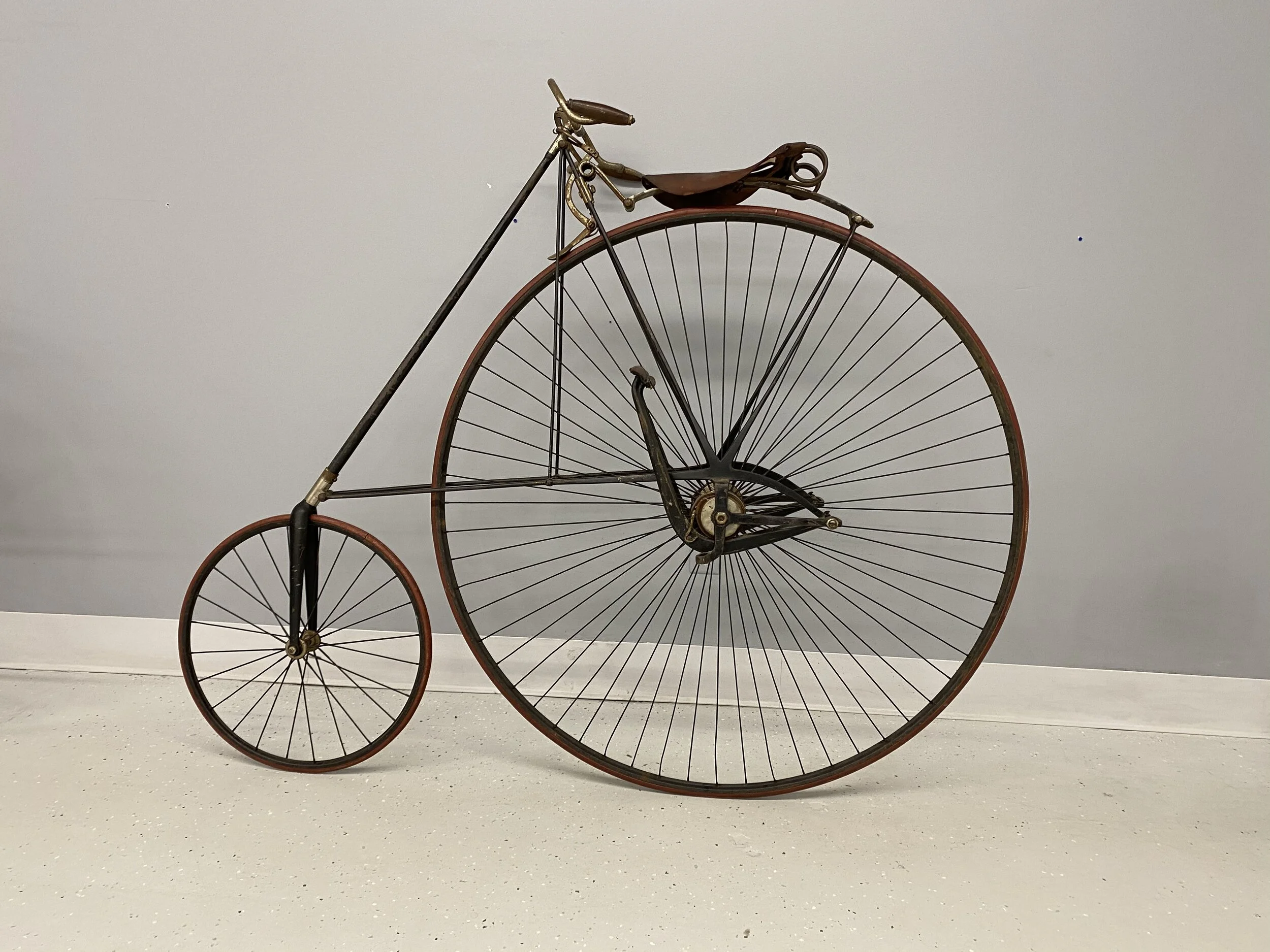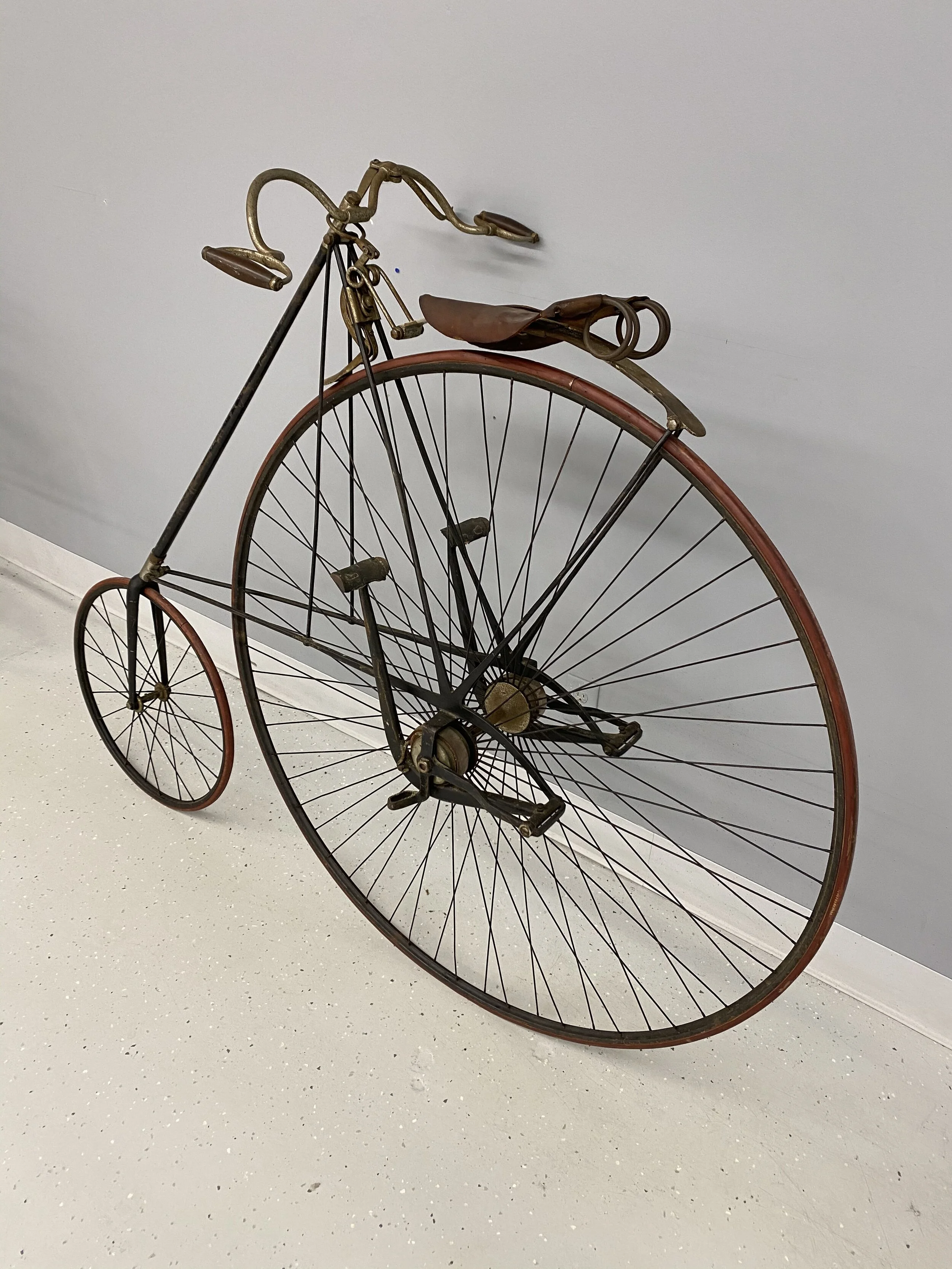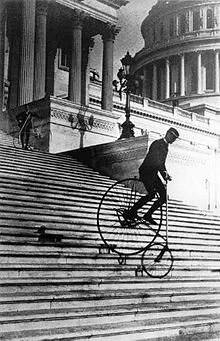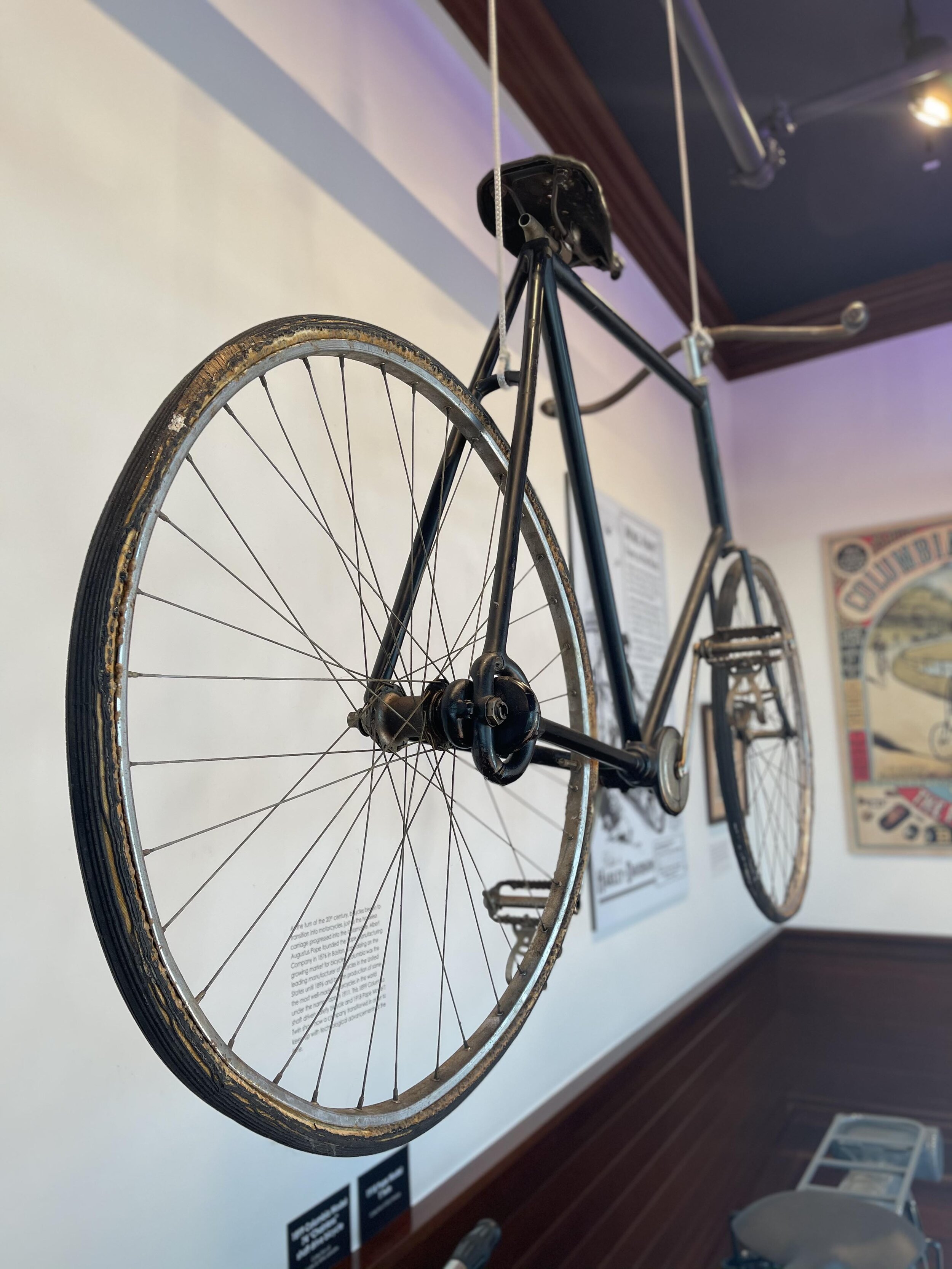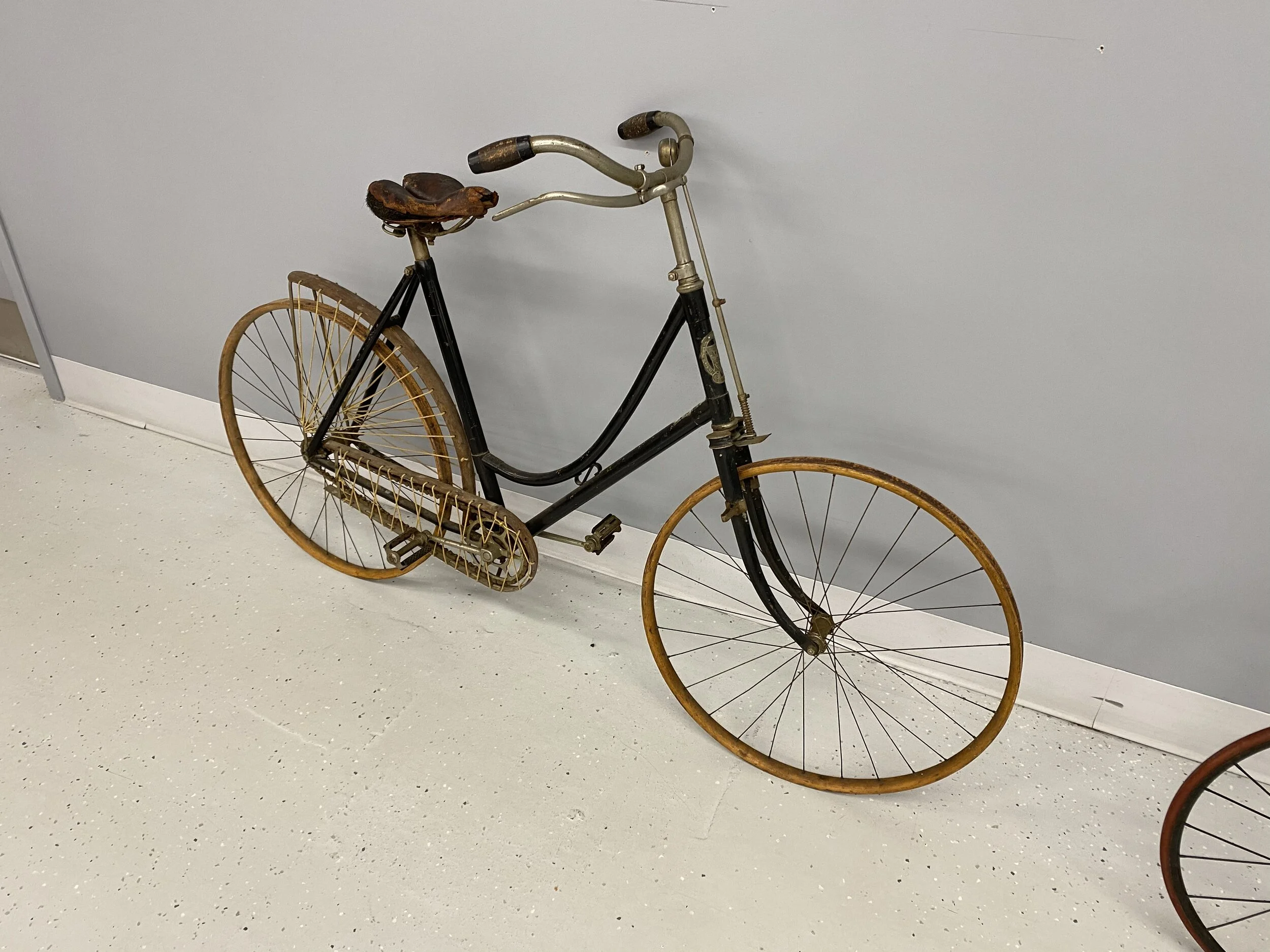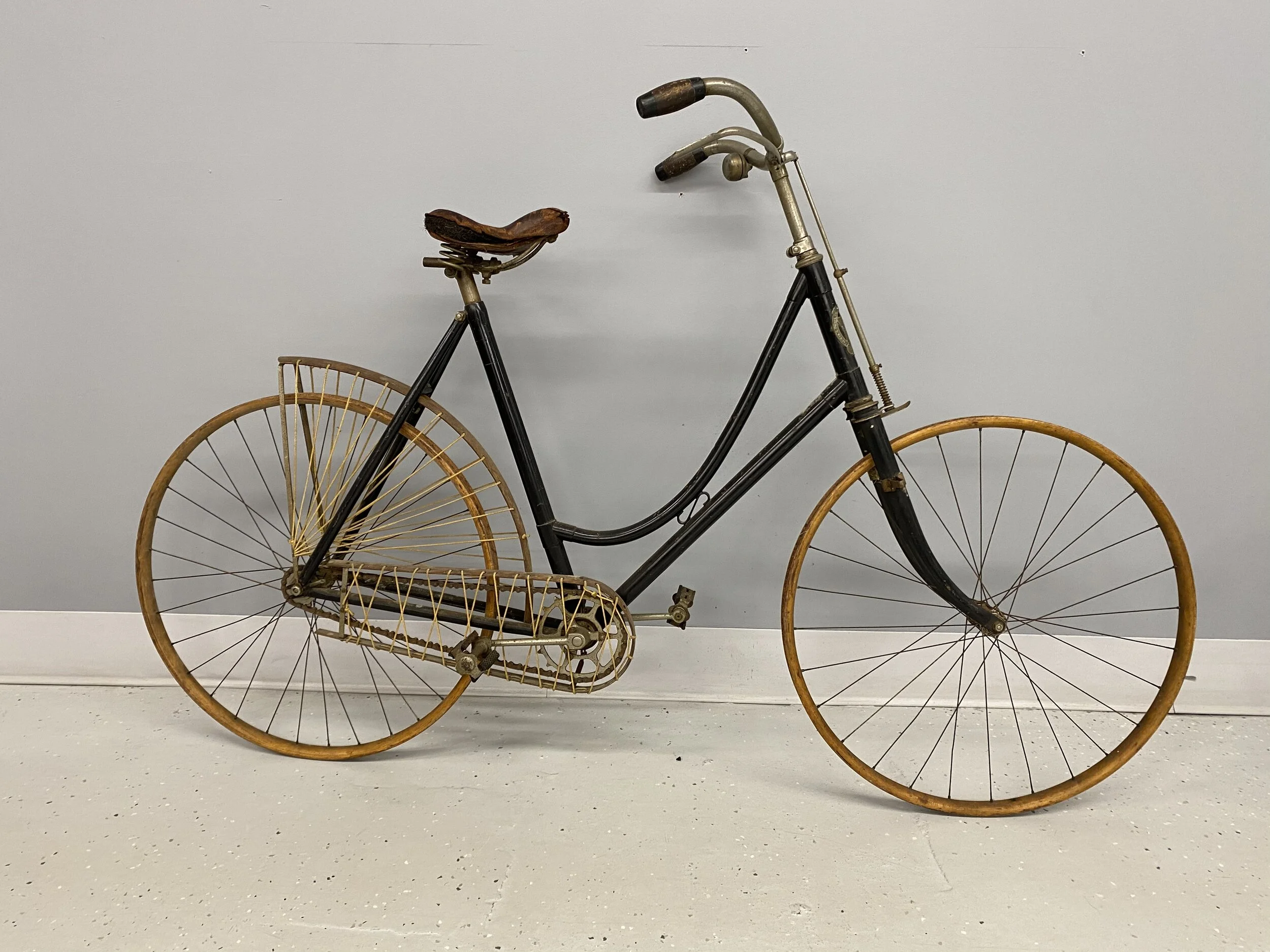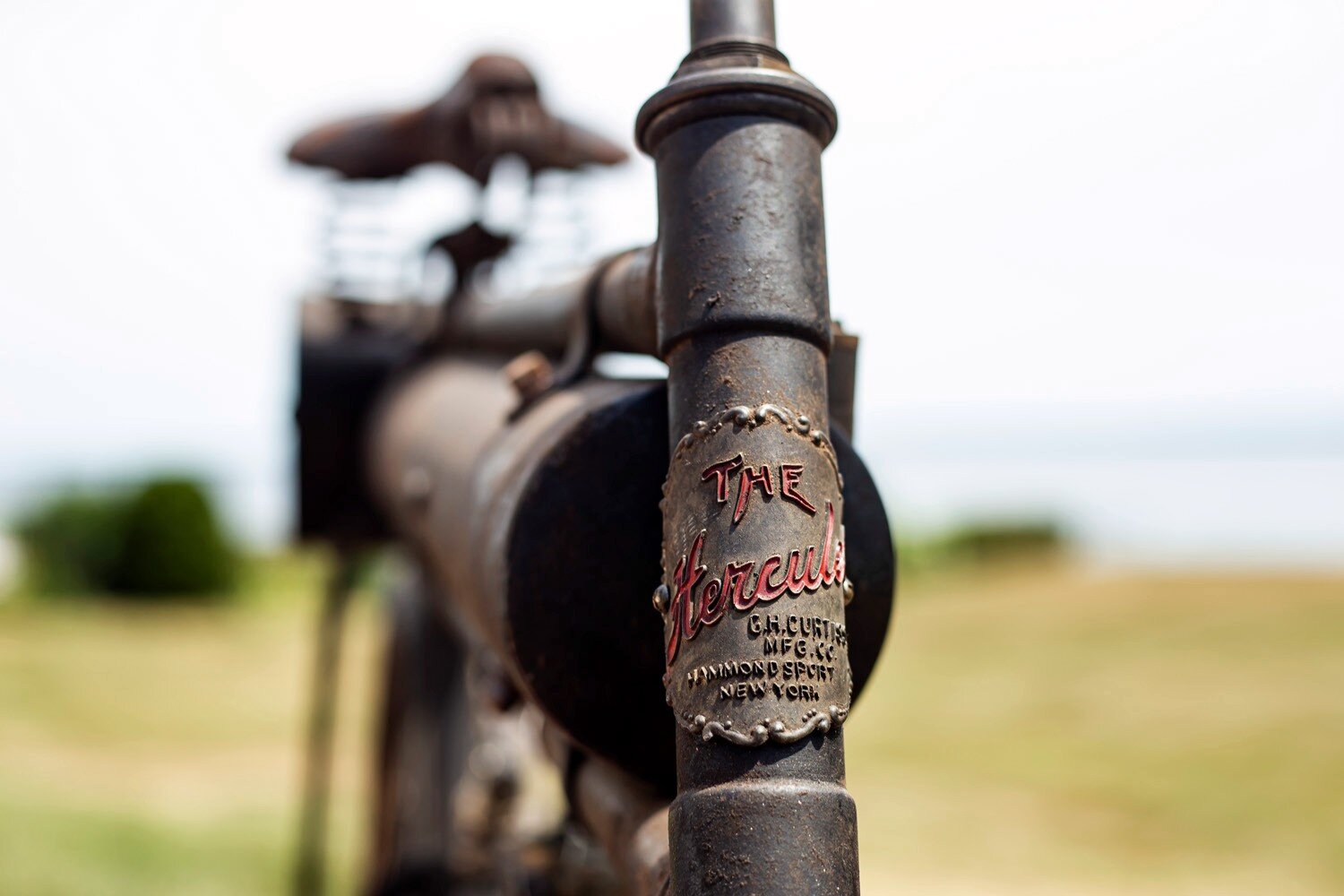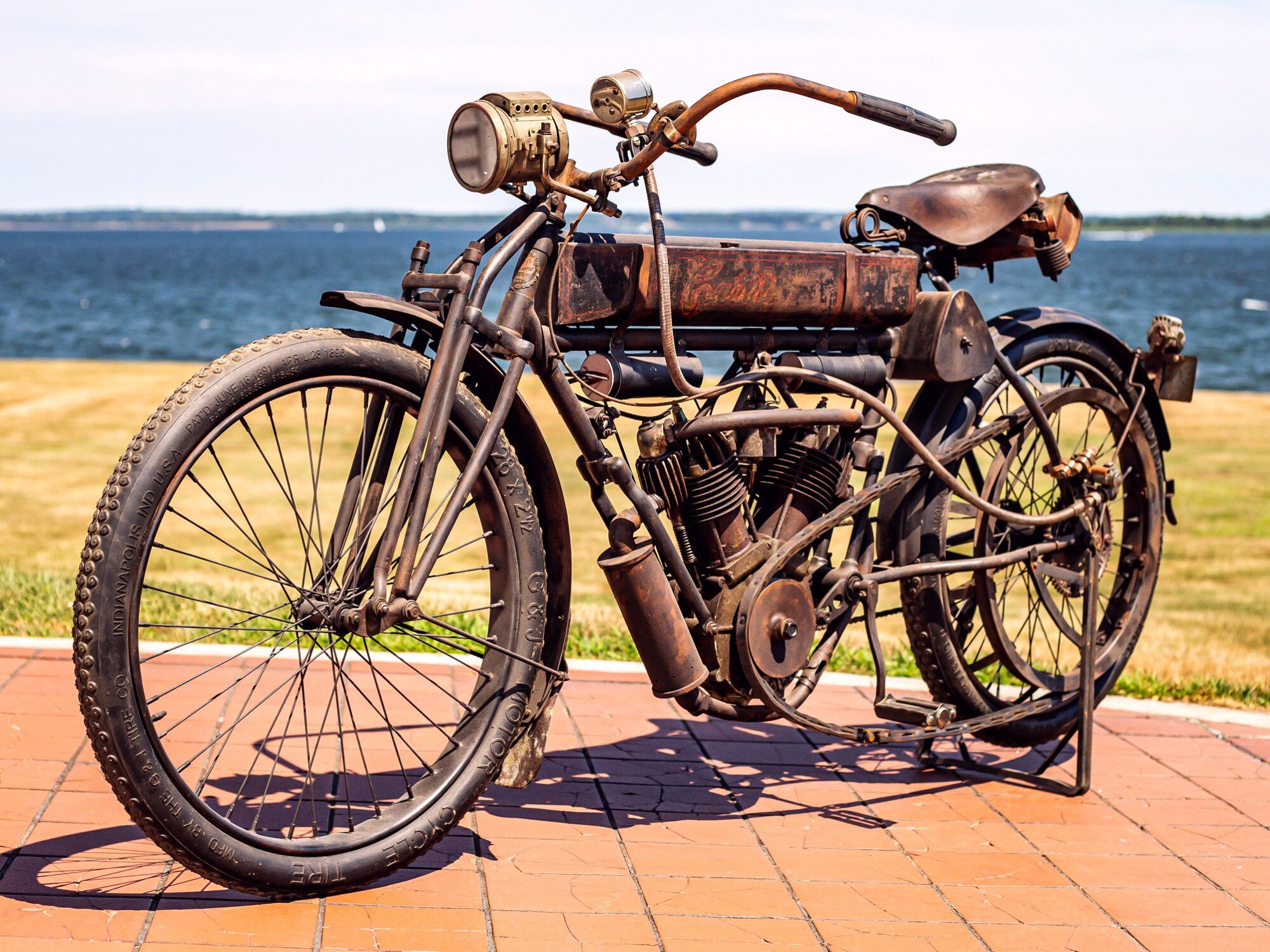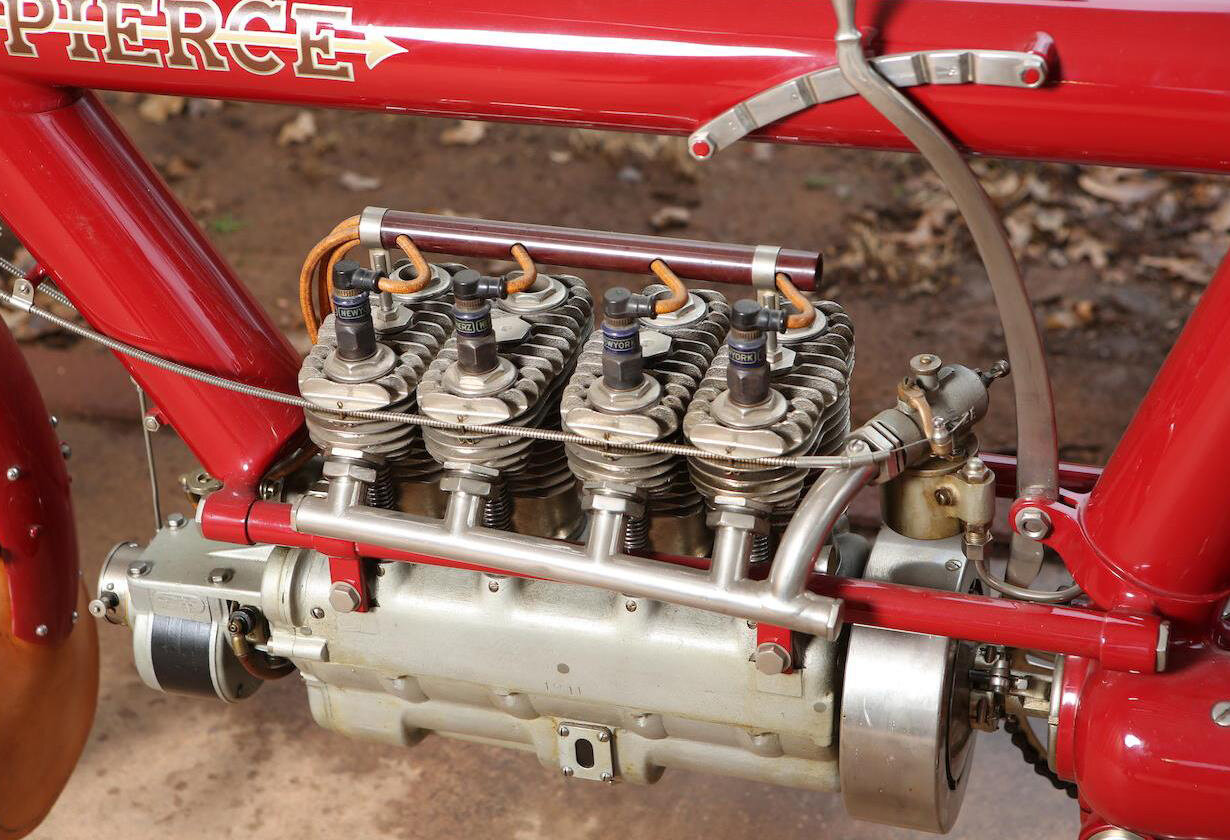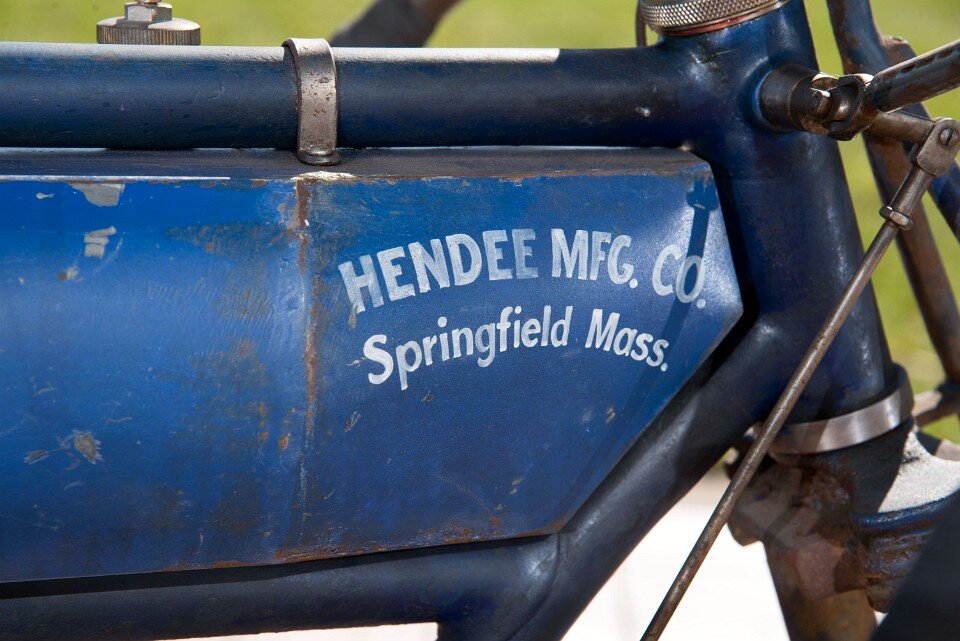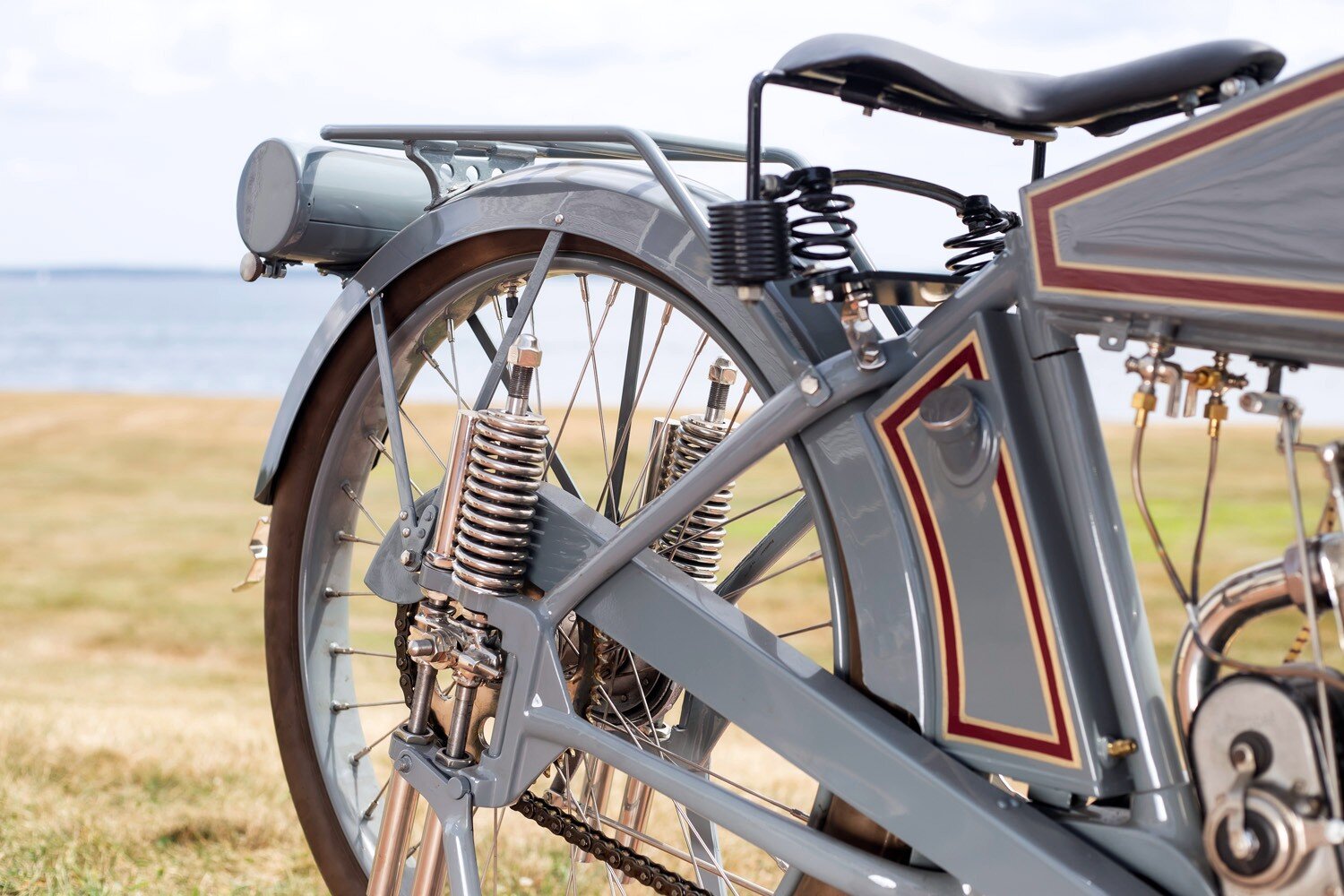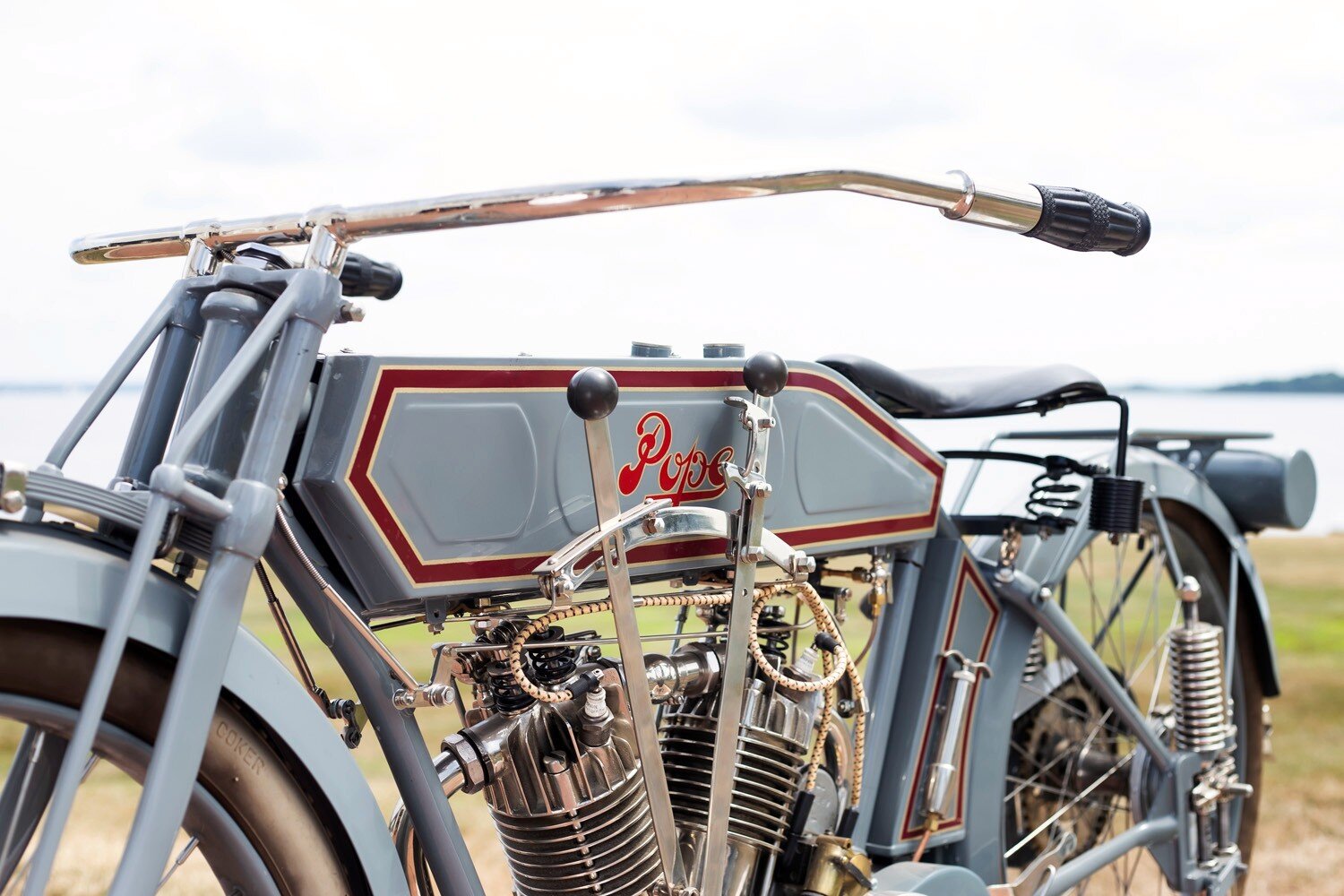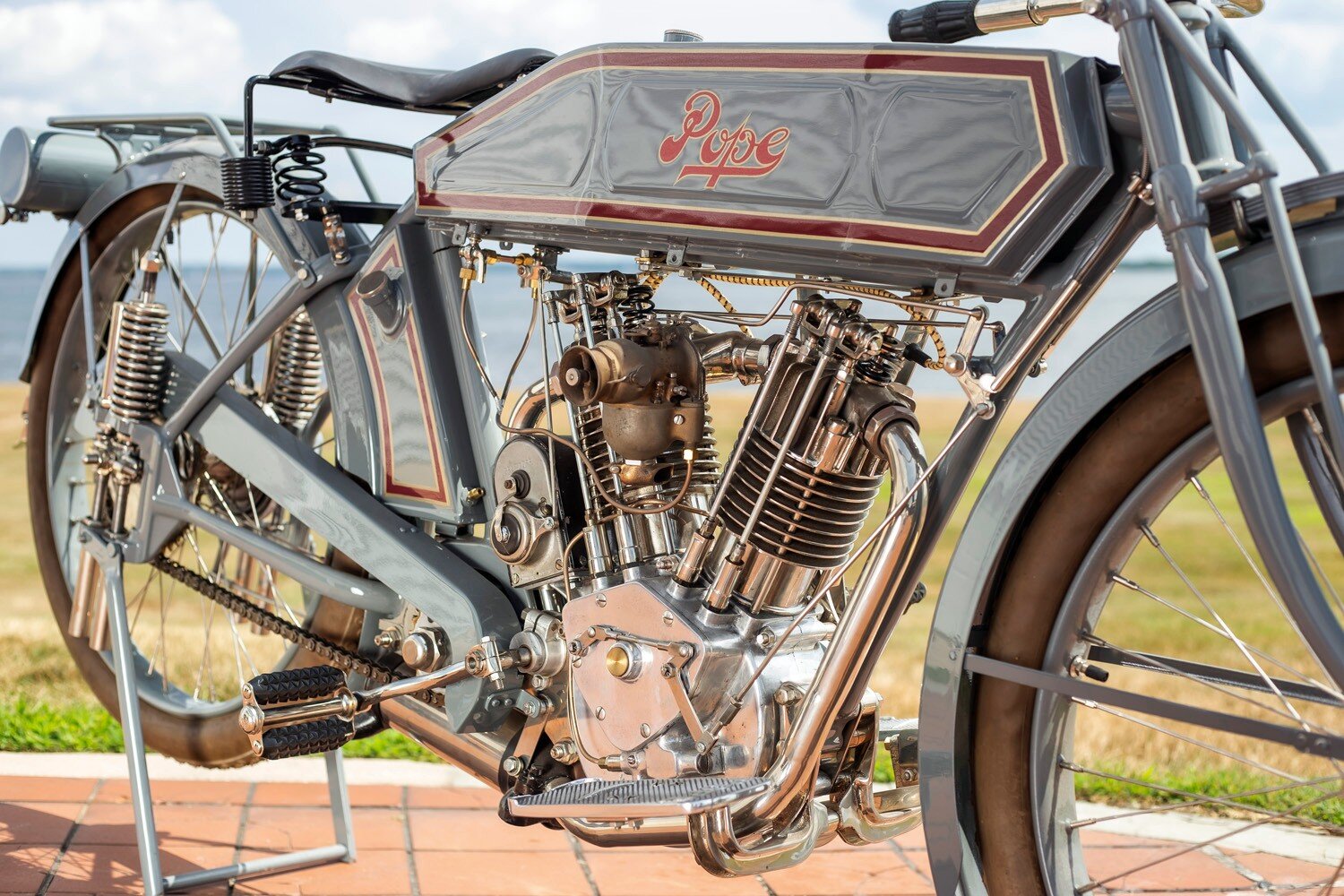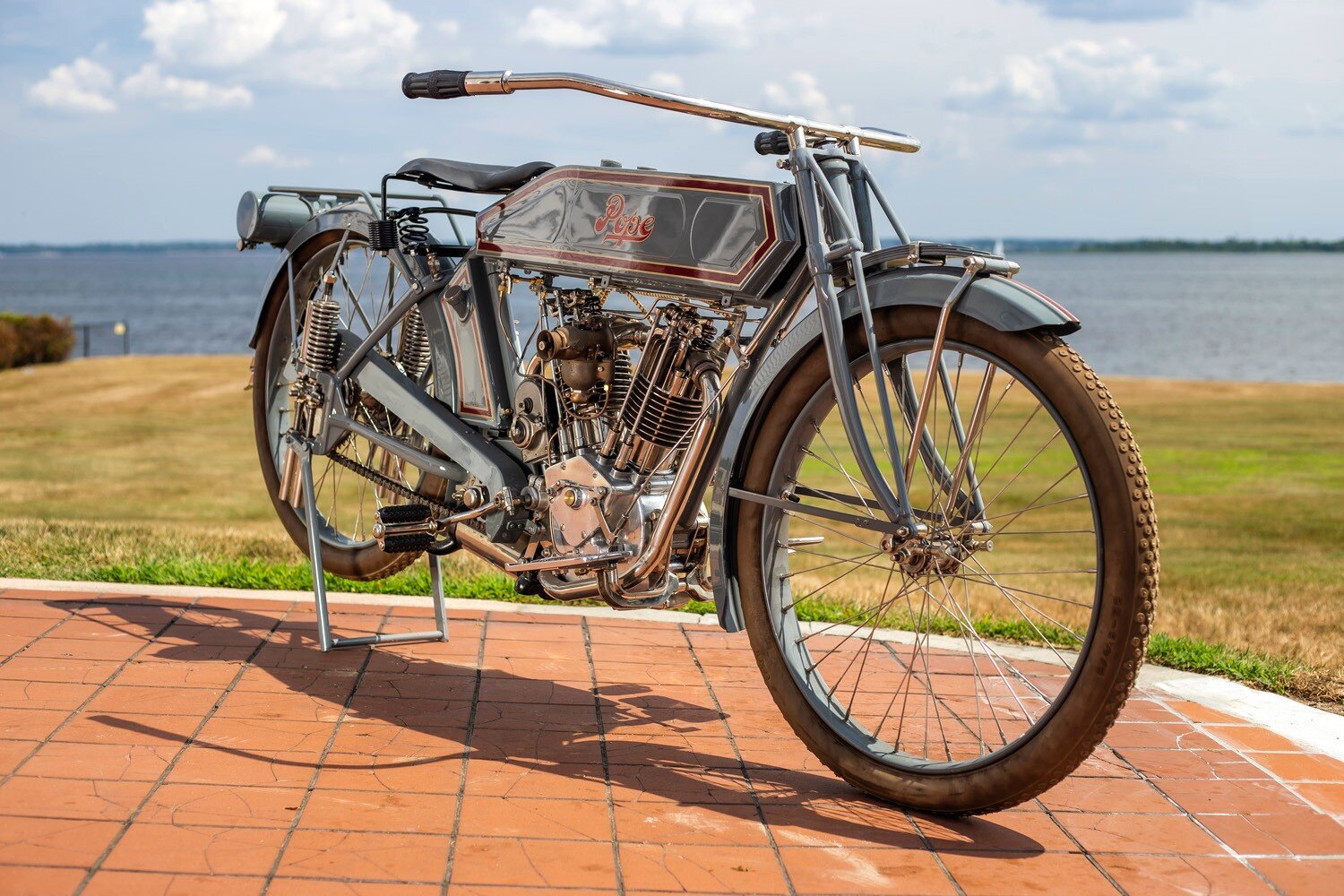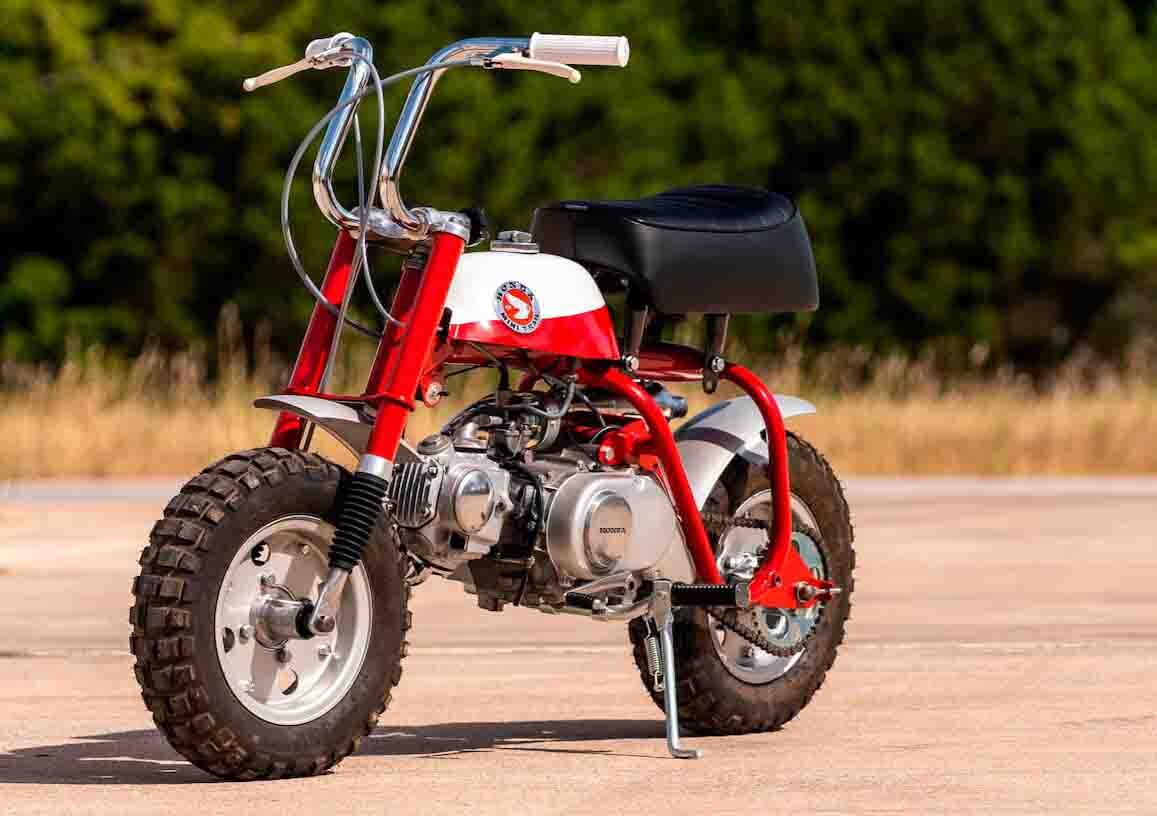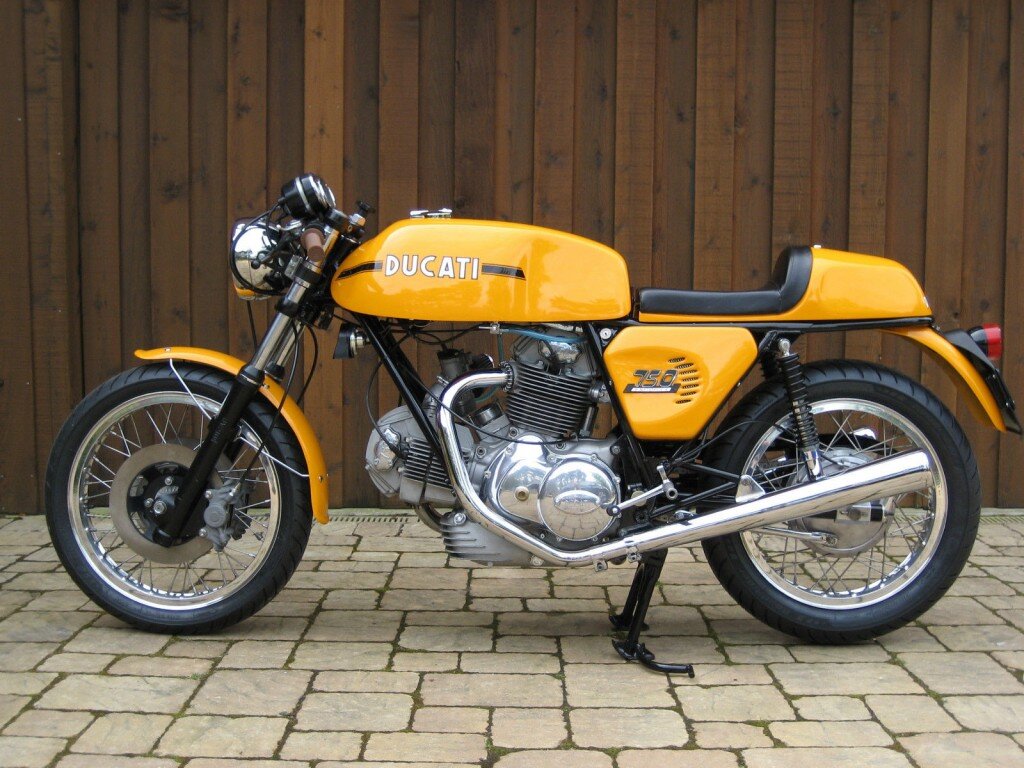The Beginning - Velocipede to Bicycle to Motorized Bicycle to Motorcycle
The freedom to ride using your own strength and balance, without a horse, really came to life with the industrialized development and growing popularity of bicycles and tricycles for the upper middle class of the late 19th Century. Bicycles followed a similar rapid progression of technology as the horse drawn carriage developed into the horseless carriage, then to the automobile.
“Velocipede” was a common term for the first pedal-equipped bicycle. Developed in the 1850s and 60s, the French company Michaux were the first to mass-produce the “boneshaker”, so nicknamed for its jarring ride made of a stiff wooden frame and wheels, with metal band tires. Advances in metalworking in the 1870s produced the first all-metal velocipedes, still with direct drive with pedals driving the front wheel. By the 1880s the high-wheel bicycle enjoyed popularity among daring young men. Larger diameter wheels allowed for faster riding. Despite a more comfortable ride, owing to spoke laced wheels and solid rubber tires, the high center of gravity over the front wheel hub led to many “headers” or being thrown over the handlebars to certain injury.
While tricycles remained popular with gentlemen and women, the safety bicycle, or simply the “Safety” gained popularity the late 1880s. Marketed as safer than the high wheel bicycles, these new designs featured two wheels the same size with the rider’s weight centered between the wheels. Geared chain-drive, Dunlop pneumatic tires, and better braking brought the technology to what we now consider the direct ancestor to the modern bicycle. Overman Wheel Company, founded in 1882 in Chicopee, Massachusetts, was the first manufacturer of safety bicycles in the United States. Examples by Columbia and Pierce can be seen in this exhibit.
Experimental motorized bicycles began in America with the American Roper steam powered velocipede of 1869, built by Sylvester H. Roper of Roxbury, Massachusetts. By 1901 the California Motor Company began selling gasoline powered bicycles. In the summer of 1903, George A. Wyman rode a 200 cc, 1.5-horsepower motored bicycle from San Francisco to New York City, becoming the first person to cross the continent riding a motorized vehicle.
By 1903 motorized kits could be bought and added to an existing bicycle or incorporated into a bicycle made with a heavier tubular frame, like the 1901 Hercules, 1923 Merkel Motor Wheel, and 1950s Schwinn Whizzer on view.
The 1900 Pierce safety bicycle and 1910 Pierce Four motorcycle and the 1885 Columbia bicycle and 1918 Pope motorcycle, all seen in the exhibition, illustrate this development within a given brand. By 1916, some manufacturers, including Harley Davidson, ended the use of pedal start with the introduction of the kick starter, introducing the first true motorcycle.
CLICK THE NAMES BELOW TO READ MORE
+ 1880’s Bone Shaker Velocipede
On loan from the collection of Charles & Aline LeMaitre, Hardwick, MA This French made 1880s velocipede is a refinement of 1860s all wood frame & wheels with 38.5” iron tire in the front. “Bone Shaker” nicknamed given its harsh riding characteristics. The frame is made of cast iron, with an iron leaf-spring seat support. The “wagon wheels” are still of wood with iron band tires. This design proceeds the high wheeler with was much faster given the larger diameter direct drive front wheel.
+ 1886 Rudge Coventry Rotary tricycle
This chain-driven tricycle, made by Rudge Cycle Company in 1885, offered health and recreation options for women and gentlemen unable to mount the unwieldy high wheeler or “Ordinary”. The Rudge has a somewhat unusual configuration with a 50” drive wheel and two smaller steering wheels on one side.
The tricycle became very popular in Britain and by 1879, there were over 20 types of multi-wheeled cycles produced in Coventry, England. By 1884, there were reportedly over 120 different models, including tandem tricycles, produced by 20 manufacturers. Tricycles were user friendly and had the stability of three wheels. They allowed Victorian women the opportunity to pedal down the street in dresses, not requiring special attire.
In 1877, James Starley developed on the first rotary chain drive tricycles, he called the Coventry Rotary. Rudge Whitworth Cycles was the British bicycle, bicycle saddle, motorcycle and sports car wheel manufacturer that resulted from the merger of two bicycle manufacturers in 1894, Whitworth Cycle Co. and Rudge Cycle Co. of Coventry.
The company also produced Rudge motorcycles from 1911 to 1946. A 1937 Rudge Ulster can be seen in this exhibit. The firm was known for its innovations in engine and transmission design, and its racing successes. Their sales motto was "Rudge it, do not trudge it." Also, the company produced the first knockoff wire wheels for sports cars up into the 1960s.
+ 1885 Columbia, "Ordinary" high-wheel bicycle
This imposing bicycle is the tallest of the high wheelers and was set up for racing.
High-wheel bicycle enjoyed popularity among daring young urban well-to-do men through the 1880s. Larger diameter wheels allowed for faster riding. Despite a more comfortable ride, owing to spoke laced wheels and solid rubber tires, the high center of gravity over the front wheel hub led to many “headers” or being thrown over the handlebars to certain injury.
In 1878 Albert Augustus Pope started production of his "Columbia" high wheelers in Hartford, Connecticut, at the Weed Sewing Machine Company factory. He shrewdly acquiring many applicable patents needed for his bicycle production. Pope aggressively took his competitors to court over these acquired patents. The courts supported many of his claims, and competitors either paid royalties of $10 per bicycle, or he forced them out of business.
Pope also introduced mechanization and mass production (later copied and adopted by Ford and General Motors) that led to leading bicycle and motorcycle production in the United States. A rare example from Pope’s last year of motorcycle production is on view in this exhibit, the 1918 Pope model T twin.
+ 1886 American Star
This high wheeler is in a remarkable state of preservation, not ever having been restored.
G.W. Pressey invented the improved treadle powered high-wheeler American Star Bicycle in 1880. Distinguished with its smaller front wheel was designed to avoid tipping forward like on “Ordinary” high wheelers, decreasing "headers" or over the handlebar falls.
Power from the treadle stoke was transferred to the rear wheel by a leather strap clutch and ratchet mechanism which could be adjusted to allow multiple gear ratios. The treadles could be worked alternately or simultaneously spurts for increased torque.
An 1888 advertisement lists prices from $75 to $120, depending on wheel size and finish, with options from "plainly finished machine; painted and striped" to "all nickled and polished, except the rim, which is painted and striped in gold”.
A Star bicycle was famously photographed being ridden down the steps in front of the United States Capitol by Will Robertson of the Washington Bicycle Club, in 1885, to demonstrate its inline stability. Star bicycles were known to be skittish in gravel due to the light front end but were used on turf for the sport of bicycle polo in the mid-1880s.
+ 1899 Victor “Half-Heart” Safety Bicycle
On Loan from the Larz Anderson Auto Museum, Brookline, Massachusetts
This Victor model safety bicycle was the zenith of design with its “Half-Heart” shaped articulated suspension fork, sprung seat frame, and hollow pneumatic tires to improve ride quality on the rough roads in the late 19th Century. In today’s eyes, this bicycle has a fantastic sculptural quality like none other! The Victor was the flagship product of the Overman Company, was manufactured of all steel parts (no cast metal parts) and was one of the first made extensive use of interchangeable parts, an innovation which allowed the owner to make repairs, without bringing the bicycle to professional mechanic. Overman Wheel Company (1882 – 1900), in Chicopee Falls, Massachusetts was the first manufacturer of the safety bicycle in America. In 1888 the company began making its own bicycles, producing nearly 80,000 bicycles per year. OWC was the only bicycle factory at the time to produce all the components making the entire bicycle in one factory.
+ 1900 Pierce Cushion Frame women’s safety bicycle
This Pierce Cycle safety bicycle is an unrestored example of their premier women’s bicycle model with Cushion-Frame. The “ladies and misses” bicycle cost $85 with 28-inch wheels and $10 more for “cushion tires”. Weighing less than 25 pounds, with seamless tubing, the sales catalog states the company has made “a substantial advance toward the perfecting of twentieth century steed, the modern bicycle”.
Before 1910 Pierce Cycles offered a wide range of models including speedy racers endorsed by Frank Kramer, who held the national bicycle championship for 16 consecutive years.
The Pierce name is also associated with motorcycles and automobiles. In 1910 Pierce offered the four cylinder motorcycle with innovative in-frame gas and oil tanks. In the gallery you will see a restored 1910 Pierce Four-Cylinder Model in the only optional color red.
+ 1902 Hercules
On loan from Dick Shappy, Warwick, RI
The earliest known example of this extremely rare, unrestored motorcycle. Produced by G. H. Curtiss Manufacturing Company Hammondsport, New York. Dale Axlerod, the premier Curtiss historian, and expert explains the VIN "126" represents 1 - the first and earliest run of Hercules engines. 2 - manufactured circa 1902. 6 - the sixth engine produced. Also in the gallery is Curtiss’ last motorcycle, the 1909 V-Twin.
Specifications:
- Single cylinder, 2.5 HP
- Leather belt drive
- 56" wheelbase, 125lbs.
+ 1909 Curtiss V-Twin
Whether discussing four- or two-wheeled automobiles, it is always rare to see a 112 year old object that remains completely in its original condition. Curtiss produced some of the most innovative, high performance motorcycles in the early 20th century, with much success stemming from Glenn Curtiss’ personal land-speed record on his V8 powered motorcycle. This air-cooled V-Twin Roadster on display employs splash lubrication for oiling and dry-cell battery ignition, helping the V-Twin produce 8 horsepower. Considered the ‘Duesenberg of early American motorcycles’, this 1909 Curtiss is one of the most well-preserved motorcycles in the world today.
Glenn Curtiss was born in 1878 in Hammondsport, New York, delivering Western Union messages on his bicycle during his youth. Curtiss also became involved in bicycle racing in his youth, and became drawn to motorcycles as internal combustion engines became more prevalent.
Curtiss began to manufacture motorcycles with his own one cylinder engines in 1902, utilizing a tomato soup can to act as the carburetor on the first engine he built. Curtiss motorcycles were often entered into lengthy endurance races such as the 1904 New York to Cambridge, Maryland race, beating everything in its way including rival Indian motorcycles. One week after this endurance race, E.H. Corson from the Hendee Manufacturing Company (producer of Indian motorcycles) visited Hammondsport and took a tour of the Curtiss shop. Corson was astounded that the complete Curtiss motorcycle company was housed in a back room of their shop.
“No such speed was ever made by anything but a bullet,” the Chicago Daily News proclaimed after Glenn Curtiss had set a land speed record on Ormond Beach, FL, with his experimental V8 motorcycle. Curtiss originally developed the 269 C.I. (4.4 liter) V8 for airplane use. With 40 horsepower at his disposal from the large V8, Curtiss began with a two man push start and rode two miles down the beach to get up to speed. Curtiss completed the mile-long timed run at 136.36 MPH, faster than any automobile had ever travelled before that moment, earning him the title of, “the fastest man on earth.”
Specifications:
- Engine: Air-Cooled V-Twin
- Horsepower: 10
+ 1910 Pierce Four
George N. Pierce founder of the G. N. Pierce company, manufactured bird cages and refrigerators in the late 1890’s. In 1908, George’s son Percy brought a Belgian FN Four motorcycle to the United States. Pierce studied the design and based their new Pierce bike on the FN. Using the FN for technical inspiration, the Pierce Four became the first four-cylinder motorcycle manufactured in the United States.
The Pierce engine differed from the FN’s; Pierce used efficient side valves in a ‘T-Head’ configuration, while the FN used atmospheric inlet valves. This change was so efficient, FN used the ’T-Head’ design themselves later on. Along with the unique valve design, the bike’s frame was also one of a kind; with a diameter of 3.5 inches, the steel frame housed both fuel and oil. According to its makers the Pierce would be, ‘Vibrationless, give motor car comfort and travel comfortably from a mere walking pace up to the speed of the motor car.’
Fast and well made, the Pierce soon had a string of city-to-city endurance race wins to its credit. When the Pierce Four was launched, the company had initiated a policy to strictly build luxury cars. Under the name Pierce-Arrow, the company supplied cars to high ranking officials around the world. A number of cars were sent to the White House for use of the President. Priced at $325 in 1910 when a Ford Model T could be purchased for $525, the high price reflected the quality and ingenuity of the motorcycle.
Specifications:
- Engine: 696 cc T-head inline-4 with compression release
- Horsepower: 7 HP
- Transmission: Two-speed manual
- Top Speed: 60 MPH
- Frame type: 3.5-inch tubing
- Suspension: Front: Leading link fork, Rear: rigid
- Tires: 28×2.5 in. pneumatic
- Weight: 275 lbs. (dry)
+ 1913 Indian Board Track Racer
Board track motorcycle racers in the US were the highest performance bikes of their time and in the second decade of the 20th century, Indian Motorcycles manufactured by the Hendee Company of Springfield, MA were dominant in the sport. To achieve the greatest possible speeds, these 61 Cubic Inch V-twin powered motorcycles lacked any suspension or brakes and could achieve speeds more than 114 mph on the banked oval wooden tracks. Indian was amongst the first motorcycles to use proprietary engines in their street and race motorcycles and up until WW1 was the largest manufacture of motorcycles in the world.
In 1900, Springfield bicycle builder, Oscar Hedstrom began designing a motorized bike for coaching bicycle racers that could be used by coaches to pace the riders around the pine board velodrome tracks that were popular at the turn of the century. His design was very well received, and he was hired by George Hendee, a Massachusetts industrialist in 1906. The company began selling Indian branded motorcycles for pace bikes and street transportation. Interest grew in the pace bike product as more fans turned out for the popular bicycle races on circular tracks made of wood. Soon, people began to actively race the pace bikes against each other on the oval board track and a new sport grew dramatically. Promoter Jack Prince of Los Angeles began building larger tracks around the country with track sizes ranging from ¼ mile up to 2 miles long to accommodate the increasingly powerful motorcycles. By 1910, race crowds often reached the 10,000 mark and purpose-built racers were being developed by manufacturers such as Excelsior, Thor and Merkel along with Indian and Harley Davidson.
As the motorcycles became more powerful, cylinder head temperatures often led to failures in the air-cooled side valve engines. The answer came in 1911 when Hedstrom designed an overhead 8 valve engine for Indian using 2 smaller inlet and 2 smaller exhaust valves per cylinder. The smaller valves resisted heat build up in the engine while maintaining better intake and exhaust flow which further increased performance. This 8 valve motor was only available to top level racers at the high cost of $350.
Despite safety concerns, all board track racers lacked even a clutch or brakes to slow the bike and accidents often had dire consequences compounded by injuries caused by wood splinters. While the engine was equipped with pedals for starting, power was delivered by a separate chain and sprocket assembly using direct drive with no transmission or gear changes. Indian was also one of the first manufacturers to employ engine controls on the handlebars, one for the throttle and the other for spark advance. By 1913, the Federation of American Motorcyclist decided to shift towards dirt ovals, a safer but less profitable venture.
Specifications:
- Engine Displacement: 61 Cubic Inch (1000cc)
- Horsepower: 7 HP (4 valve motor) 11hp (8 valve motor)
+ 1918 Pope Model T Twin
Albert Augustus Pope founded the Pope Manufacturing Company in 1876 at 54 High Street in Boston, capitalizing on the growing market for bicycles while also manufacturing devices such as air pistols and cigarette rolling machines. Pope transitioned to motorcycle production by 1911, leading to the culmination of their developments: this Pope Model T Twin you see here.
Pope began to sell imported English penny farthing bicycles in 1878 and started to manufacture their own line of bicycles that same year, with all parts manufactured in house under the brand name Columbia. On penny farthing bicycles, the rider sits high and above the large front wheel, leading to frequent accidents where riders would be thrown head-first over the front of the bike. Several manufacturers began to manufacture ‘safety’ models, or low mount bicycles, like the bicycles we are so familiar with today. Alfred Pope was not initially sold by this new style of bicycle, calling them a fad. An independent bicycle agent named George Bidwell approached Pope a year later, further probing him to design safety bicycles, claiming “the old high wheel was doomed.” Pope not only began production of safety bicycles, he started to buy up as many original bicycle patents as he could, charging other manufactures royalties for using his patents. Pope was the leading manufacturer of bicycles in the United States until 1896.
As Pope transitioned into motorcycle production around 1911, their products quickly became renowned for their quality craftsmanship and innovative technology. Early Pope’s featured a simple single cylinder engine before introducing a more powerful V-twin in 1912.
The 1918 Pope was last in a great line of motorcycles from the New England based manufacturer. During this period, many motorcycles did not include any suspension on the bike, instead choosing to equip the seat with springs to help cushion the rider. Contrarily on this Pope, it left the factory with both front and rear suspension, making the bike feel much more comfortable and confident on spotty roads. The 1000 CC overhead valve engine had plenty of power and torque to take riders anywhere they needed to go. A peculiar feature of this bike is the left foot pedal, when engaged halfway, it serves as the clutch, though when pushed as far as possible the pedal serves as a brake. This is the most powerful Pope that left their factory, built shortly before the company suspended motorcycle production and turned their focus to machine gun production as World War I became a harsh reality.


